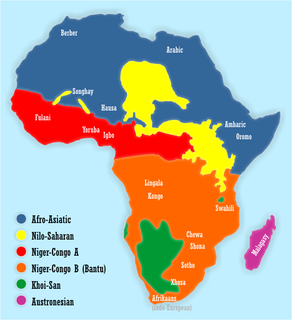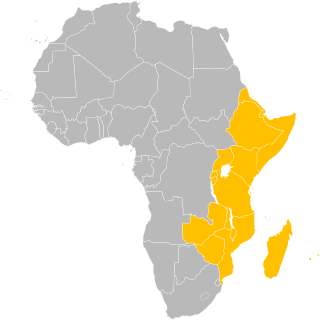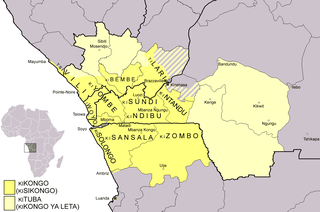Further reading
- Biebuyck, Daniel P. De hond bij de Nyanga: ritueel en sociologie. Gembloux: J. Duculot, 1956.
| National libraries | |
|---|---|
| Other | |
The Nyanga (also Banianga, Banyanga, Kinyanga, Nianga or Nyangas) are a Bantu people in the African Great Lakes region. Today they live predominantly in the Kivu region of the Democratic Republic of the Congo, near the frontier with Rwanda and Uganda. [1] They speak the Nyanga language, also called Kinyanga, which is one of the Bantu languages. There are about 150,000 speakers of Nyanga according to a 1994 census, but most are also fluent in Swahili. Their national epic is the karisi Mwindo .

The Bantu languages are a large family of languages spoken by the Bantu peoples in the southern half of Africa. They form the largest branch of the Southern Bantoid languages.

Niger-Congo is a hypothetical language family spoken over nearly the entirety of sub-Saharan Africa. It unites the Mande languages, the Atlantic-Congo languages, and possibly several smaller groups of languages that are difficult to classify. If valid, Niger-Congo would be the world's largest in terms of member languages, the third-largest in terms of speakers, and Africa's largest in terms of geographical area. It is generally considered to be the world's largest language family in terms of the number of distinct languages, just ahead of Austronesian, although this is complicated by the ambiguity about what constitutes a distinct language; the number of named Niger-Congo languages listed by Ethnologue is 1,540.
Luba-Kasai, also known as Western Luba, Bena-Lulua, Ciluba/Tshiluba, Luba-Lulua or Luva, is a Bantu language of Central Africa and a national language of the Democratic Republic of the Congo, alongside Lingala, Swahili, and Kikongo ya leta.

Khoisan, or according to the contemporary Khoekhoegowab orthography Khoe-Sān, is a catch-all term for those indigenous peoples of Southern Africa, who don't speak one of the Bantu languages, combining the Khoekhoen and the Sān or Sākhoen.

East Africa, Eastern Africa, or East of Africa is the eastern sub-region of the African continent. In the United Nations Statistics Division scheme of geographic regions, 19* territories make up Eastern Africa:

The Bantu expansion was a major series of migrations of the original Proto-Bantu-speaking group, which spread from an original nucleus around West-Central Africa across much of sub-Saharan Africa. In the process, the Proto-Bantu-speaking settlers displaced or absorbed pre-existing hunter-gatherer and pastoralist groups that they encountered.

Kongo or Kikongo is one of the Bantu languages spoken by the Kongo people living in the Democratic Republic of the Congo, the Republic of the Congo, Angola and Gabon. It is a tonal language. It was spoken by many of those who were taken from the region and sold as slaves in the Americas. For this reason, while Kongo still is spoken in the above-mentioned countries, creolized forms of the language are found in ritual speech of Afro-American religions, especially in Brazil, Cuba, Puerto Rico, Dominican Republic and Haiti. It is also one of the sources of the Gullah language and the Palenquero creole in Colombia. The vast majority of present-day speakers live in Africa. There are roughly seven million native speakers of Kongo, with perhaps two million more who use it as a second language.
Sanga may refer to:

South African Bantu-speaking peoples are the majority of Black South Africans. Occasionally grouped as Bantu, the term itself is derived from the word for "people" common to many of the Bantu languages. The Oxford Dictionary of South African English describes its contemporary usage in a racial context as "obsolescent and offensive" because of its strong association with white minority rule with their Apartheid system. However, Bantu is used without pejorative connotations in other parts of Africa and is still used in South Africa as the group term for the language family.
Nyanga-li (Linyanga-le) is a Bantu language in Orientale Province, Democratic Republic of the Congo. Gbati-ri (Gbote) is a dialect. Maho (2009) lists them separately as unclassified Zone D.30 languages, but Ethnologue states that they are "members of the same dialect subgroup", and Glottolog places them nearest the Ngendan languages.
The Nyanga language is a language spoken by the Nyanga people in Kivu province, north-eastern Democratic Republic of the Congo. Speaker estimates range from 27,000 to 150,000. Many of the Nyanga speak Congo Swahili, the dominant regional lingua franca, as a second language. Nyanga is a Bantu language. Most of the (scarce) linguistic research conducted on Nyanga has been based on the materials published by Biebuyck and Mateene.
The Prehistory of South Africa lasts from the Middle Stone Age until the 17th century. Southern Africa was first reached by Homo sapiens before 130,000 years ago, possibly before 260,000 years ago. The region remained in the Late Stone Age until the first traces of pastoralism were introduced about 2,000 years ago. The Bantu migration reached the area now South Africa around the first decade of the 3rd century, over 1800 years ago, largely displacing the indigenous Khoisan population.Early Bantu kingdoms were established by the 11th century. First European contact dates to 1488, but European colonization began in the 17th century.
Yao is a Bantu language in Africa with approximately two million speakers in Malawi, and half a million each in Tanzania and Mozambique. There are also some speakers in Zambia. In Malawi, the main dialect is Mangochi, mostly spoken around Lake Malawi. In Mozambique, the main dialects are Makale and Massaninga. The language has also gone by several other names in English, including chiYao or ciYao, Achawa, Adsawa, Adsoa, Ajawa, Ayawa, Ayo, Ayao, Djao, Haiao, Hiao, Hyao, Jao, Veiao, and waJao.
Baka is a dialect cluster of Ubangian languages spoken by the Baka Pygmies of Cameroon and Gabon. The people are ethnically close to the Aka, the two together called the Mbenga (Bambenga), but the languages are not related, apart from some vocabulary dealing with the forest economy, which suggests the Aka may have shifted to Bantu, probably 15000 people have shifted.
Fipa is a Bantu language of Tanzania. It is spoken by the Fipa people, who live on the Ufipa plateau in the Rukwa Region of South West Tanzania between Lake Tanganyika and Lake Rukwa. The ethnic group of the Fipa people is larger than the group of Fipa language speakers. On the Tanzanian side, people who speak Mambwe-Lungu may identify as Fipa and consider their language to be a dialect of Fipa. Lungu and Mambwe are also spoken in Zambia where they are considered languages and their speakers are considered to be ethnic groups in their own right, although linguists consider Lungu and Mambwe to be dialects of a single language. There are three dialects: Milanzi, Kwa (Ichikwa) and Nkansi.
Buyu, or Buyi, is a Bantu language of Lake Tanganyika that is closely related to Nyanga.
Boan is a proposed intermediate group of Bantu languages coded Zones C and D in Guthrie's classification. There are three branches:

Bantu people are the speakers of Bantu languages, comprising several hundred indigenous ethnic groups in Africa, spread over a vast area from Central Africa, to Southeast Africa, and to Southern Africa.
Kwakum is classified as belonging to the Bantu subgroup A90 (Kaka) of the Zone “A” Bantu languages, and specifically labelled A91 by Guthrie. According to one of the newest updates to the Bantu classification system, other languages belonging to this subgroup are: Pol (A92a), Pɔmɔ (A92b), Kweso (A92C) and Kakɔ (A93). The Kwakum people refer to themselves as either Kwakum or Bakoum. However, they say that the "Bakoum" pronunciation only began after the arrival of Europeans in Cameroon, though it is frequently used today. Kwakum is mainly spoken in the East region of Cameroon, southwest of the city Bertoua.
Shungwaya is an origin myth of the Mijikenda peoples. Traditions known collectively as the "Shungwaya myth" describe a series of migrations of Bantu peoples dating to the 12th-17th centuries from a region to the north of the Tana River. These Bantu migrants were held to have been speakers of Sabaki Bantu languages. Other Bantu ethnic groups, smaller in number, are also suggested to have been part of the migration. From Shungwaya, the Mount Kenya Bantu are then proposed to have broke away and migrated from there some time before the Oromo onslaught. Shungwaya appears to have had its heyday as a Bantu settlement area between perhaps the 12th and the 15th centuries, after which it was subjected to a full-scale invasion of Cushitic-speaking Oromo peoples from the Horn of Africa. From the whole corpus of these traditions, it has been argued that Shungwaya comprised a large, multi-ethnic community.